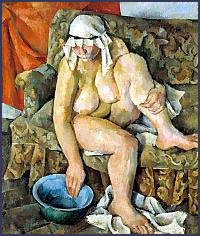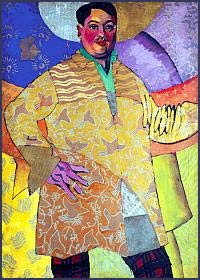Press room
"The Moscow Times", January 28, 2005.
Shock Value. Rebellious artworks go back on display, 78 years on.
He longed for freedom in the Soviet era, then left for the West in the 1990s. Now, painter Erik Bulatov comes home with a major retrospective.
 The Knave of Diamonds -- a colorful, controversial group of painters who caused an artistic sensation in pre-Revolutionary Russia -- is back. More than 120 paintings by members of the groundbreaking movement will go on display at the New Tretyakov Gallery on Wednesday in the first major exhibition of their work in Moscow since 1927.
The Knave of Diamonds -- a colorful, controversial group of painters who caused an artistic sensation in pre-Revolutionary Russia -- is back. More than 120 paintings by members of the groundbreaking movement will go on display at the New Tretyakov Gallery on Wednesday in the first major exhibition of their work in Moscow since 1927.
According to Irina Vakar, the exhibition's curator, the Knave of Diamonds group is little known in the West. Nonetheless, she added, the artists were highly influential in Russia, forming a bridge between Post-Impressionist painters like Paul Cezanne and the aggressive geometry of the Russian avant-garde.
"They were not imitators," Vakar said during a recent interview. "Their world of sensation was very Russian. It was an interesting fusion. ... There are themes that are similar to Matisse or Gauguin, but then, all of a sudden, one comes across this almost unbelievable crudeness."
The circle of artists that became known as the Knave of Diamonds came together in 1910, crystallizing around the painters Mikhail Larionov and Natalia Goncharova. Originally influenced by Impressionism, Larionov and Goncharova gradually adopted a more primitive style, inspired by the folk art of the Russian provinces. Many of their works were modeled on provincial photographs, with the awkwardly posed subjects gazing at the viewer, against a backdrop of cheap furniture and common household items.
In December 1910, the circle launched its first exhibition, titled "The Knave of Diamonds." Larionov chose the name as a direct challenge to the other artistic movements swirling around Russia in his day. While other groups had highbrow names such as The Blue Rose or The Union of Russian Artists, the term "The Knave of Diamonds" had a roguish, almost criminal connotation. In terms of its philosophy, Larionov's group was also markedly different from the others. While some groups sported a deeply serious, aesthetic approach to art, Larionov and his peers were disdainful of painters who spent their time theorizing about art instead of painting.
The reaction to the first Knave of Diamonds exhibition was stormy. Critics disliked the crowded, seemingly haphazard arrangement of canvases on the wall. One painting, "Allegory of the Patriotic War of 1812" by Aristarkh Lentulov, elicited a particularly fierce reaction -- an angry patron announced that he would voluntarily go to jail if Lentulov could decipher the meaning of his canvas and explain what it had to do with the War of 1812. (The painter offered an explanation, but it is unclear whether the visitor actually carried out his threat.)
 In 1911, Larionov and Goncharova broke off and formed a separate movement. But the Knave of Diamonds persisted until 1916 as a group of painters who held collective exhibitions. Three painters formed the group's nucleus: Lentulov, Pyotr Konchalovsky and Ilya Mashkov. Other well-known Russian artists also exhibited with the Knave of Diamonds, including Vasily Kandinsky, Kazimir Malevich, Marc Chagall and Vladimir Tatlin.
In 1911, Larionov and Goncharova broke off and formed a separate movement. But the Knave of Diamonds persisted until 1916 as a group of painters who held collective exhibitions. Three painters formed the group's nucleus: Lentulov, Pyotr Konchalovsky and Ilya Mashkov. Other well-known Russian artists also exhibited with the Knave of Diamonds, including Vasily Kandinsky, Kazimir Malevich, Marc Chagall and Vladimir Tatlin.
Many of these painters will be represented in the upcoming exhibition at the New Tretyakov Gallery. Also to be displayed are the works of several French painters, including Paul Cezanne, Paul Gauguin and Henri Matisse, who influenced the Knave of Diamonds. According to Vakar, the idea is to recreate the original atmosphere of the group's exhibitions, which featured foreign painters as well as Russians.
The group's paintings were rarely exhibited in the Soviet period, and a revival of interest only began in the 1970s. Last year saw a large retrospective exhibition held first in Monaco, and then at the Russian Museum in St. Petersburg. Now this exhibition has finally come to Moscow -- the original home of the artistic movement.
"We've been trying for a long time to show the Knave of Diamonds in all its splendor," Vakar said.
"The Knave of Diamonds" (Bubnovy Valet) runs from Wed. to Apr. 3 at the New Tretyakov Gallery, located at 10 Krymsky Val. Metro Park Kultury, Oktyabrskaya. Tel. 230-7788, 951-1362, 238-1378.
By Alexander Osipovich
Published: January 28, 2005
